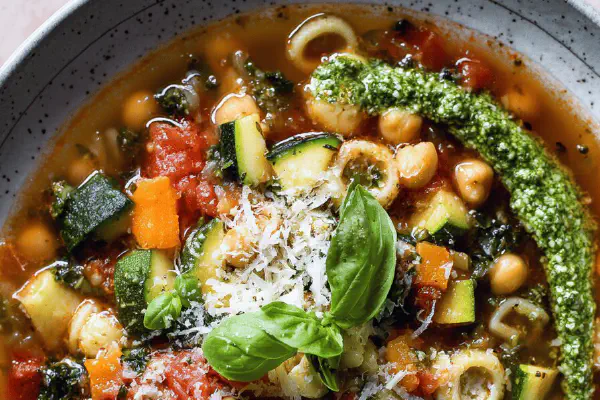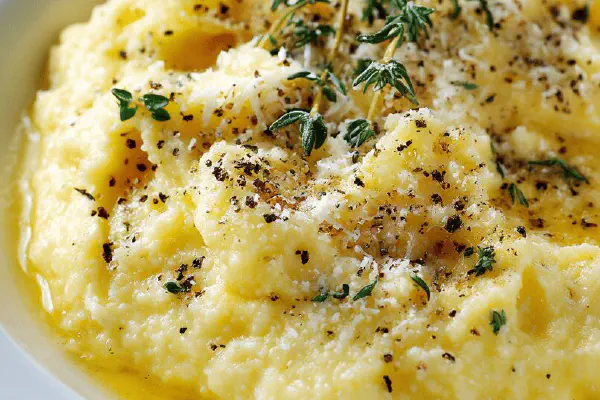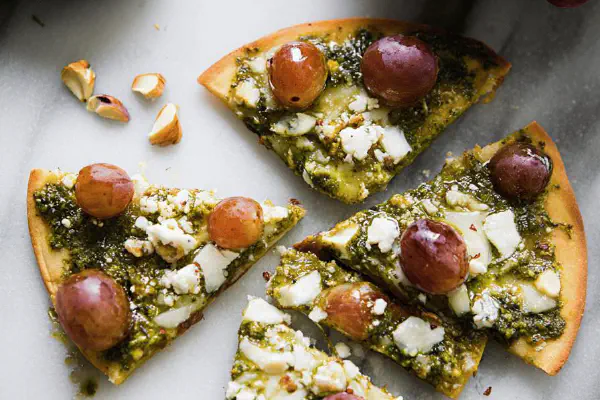Green Minestrone Soup

By Emma
Certified Culinary Professional
Ingredients
- 2 medium zucchinis, diced
- 1 small leek white part only, thinly sliced
- 1 garlic clove, minced
- 30 ml olive oil (2 tablespoons)
- 1.25 liters low-sodium vegetable broth
- 1 can 400 ml (14 oz) chickpeas, rinsed and drained
- 1 rind Parmesan cheese piece (optional but recommended)
- 150 g (about 5 cups) chopped kale instead of spinach
- 85 g (3 oz) small pasta shells or other small shaped short pasta
- 30 ml (2 tablespoons) store-bought or homemade basil pesto
- Freshly grated Parmesan, for serving
- Fresh basil leaves, optional garnish
About the ingredients
Method
- Heat olive oil in large saucepan over medium-high heat. Toss in diced zucchinis, sliced leek, and minced garlic. Sprinkle with a pinch of salt and pepper. Stir often, cook until veggies soften and start releasing aroma, 7 to 9 minutes—should smell sweet and look glossy but not browned.
- Pour in vegetable broth carefully. Add rinsed chickpeas and parmesan rind if using. Turn up heat and bring to a lively boil, watch for bubbles rising steadily. Once boiling, lower heat to medium-low and cover partially. Let simmer 6 to 8 minutes. Soup should smell fragrant, veggies tender but not mushy.
- Remove lid, taste broth; adjust salt and pepper now. Add chopped kale and pasta shells. Stir to combine, continue cooking uncovered, stirring frequently, until pasta is al dente and kale has wilted but still vibrates bright green, about 5 to 10 minutes. Watch pasta closely, test a piece every few minutes to avoid overcooking.
- Turn off heat. Quickly fold in pesto. Mix well—pesto oils will coat the soup, adding fresh herbal punch. Remove parmesan rind and discard.
- Ladle into bowls. Sprinkle freshly grated parmesan over each serving, scatter basil leaves if you have some on hand. Serve immediately for best texture; leftover pasta tends to soak up broth.
- If kale feels tough, blanch first separately and add later. If veggie scraps available, simmer them in broth for extra flavor. Swap white beans for chickpeas for nuttier texture and slight earthiness. Don’t rush the sauté step—softening those veggies is key.
Cooking tips
Chef's notes
- 💡 Start softening zucchini and leek gently in olive oil medium-high but no rush; veggies must sweat not brown. Salt early draws moisture fast, speeds softening and triggers aroma. Listen for gentle sizzling, veggies become translucent signal next step.
- 💡 When pouring broth, do it slow to control temp shock; steam rise shows heat exchange. Boil lively then dial down low simmer—vigorous bubbles break chickpeas. Keep lid partially on to trap heat but watch boil-over, adjust fast or broth spills.
- 💡 Timing pasta and kale added together tricky. Pasta needs al dente chew, kale bright green but wilted. Stir often now, prevent pasta sticking or uneven wilting. Taste pasta frequently. Chop kale fine to speed softening yet keep vibrant color.
- 💡 Fold pesto in off heat only; too hot kills fresh basil oils, dulling punch. Pesto oils coat soup surface, add herbaceous brightness. Remove parmesan rind before stirring pesto—bitterness lingers if left too long brewing.
- 💡 Use chickpeas for nuttier texture; white beans too soft, mushy in this broth. If kale tough, blanch quickly separately, add later just before serving. Vegetable scraps simmer added flavor, but strain well to keep broth clear, avoid muddy taste.
Common questions
Can spinach replace kale here?
Yes, weaker green, wilts faster so add later or less. Spinach cooks soft, loses bright color quick. Kale holds shape, better if you want chew and visual pop.
What to do if pasta overcooks?
Rescue with extra broth, loose soup texture. Serve immediately. Or cook pasta separately, add last to control doneness. Pasta absorbs broth fast if sitting, swells even more.
How to make broth taste less flat?
Taste as it simmers. Add salt slow. Acidic like squeeze lemon or vinegar brightens. Umami from parmesan rind helps. Herbs at end, pesto or basil also lift flavor complexity.
Best storage method?
Cool before fridge. Store pasta separate if possible to avoid sogginess. Leftovers reheat gently, add broth to refresh texture. Soup thickens over time; add water broth to loosen. Basil best fresh, add just before serving.



